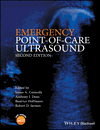How Does Ultrasound Work?
Summary
This chapter outlines the basics of how ultrasound works, and introduces the construction of an image and some of the physical principles that govern the behaviour of sound in tissue. During an ultrasound examination, most of the diagnostic conclusions about normal and abnormal appearances are based on pattern recognition. This includes a number of key observations: the spatial definition of tissue boundaries; relative tissue reflectivity; echo-texture; and the effect of tissue on the transmission of sound. These appearances are determined by the physical properties of the ultrasound waves and their interactions with tissues. Reflection of the ultrasound pulse occurs at interfaces between two media that have differences in acoustic impedance, which are a medium's physical properties as a transmitter of sound. Absorption is the process by which the mechanical energy carried by the pulse is converted into heat within the tissues.



